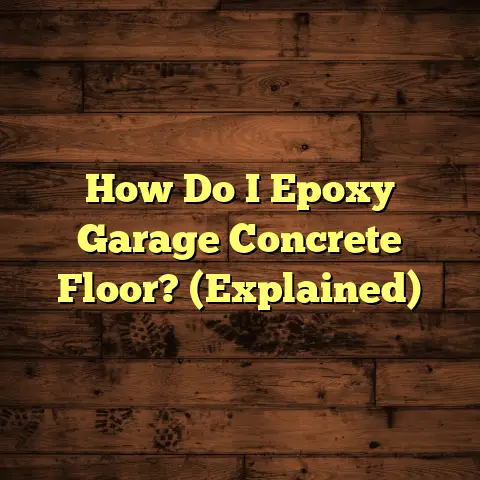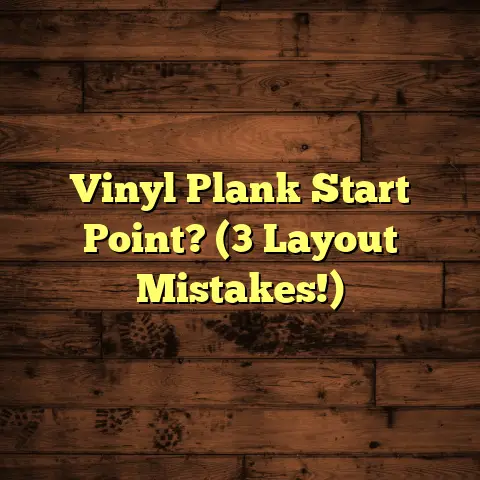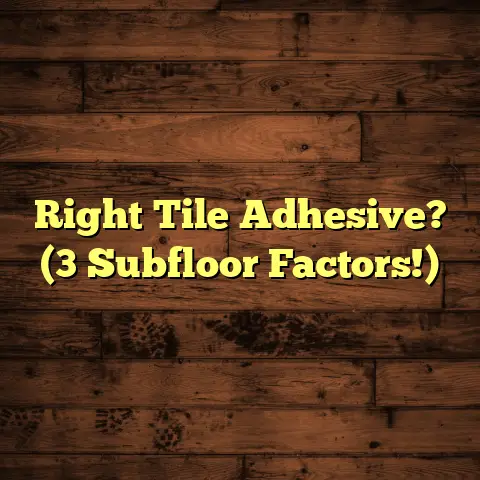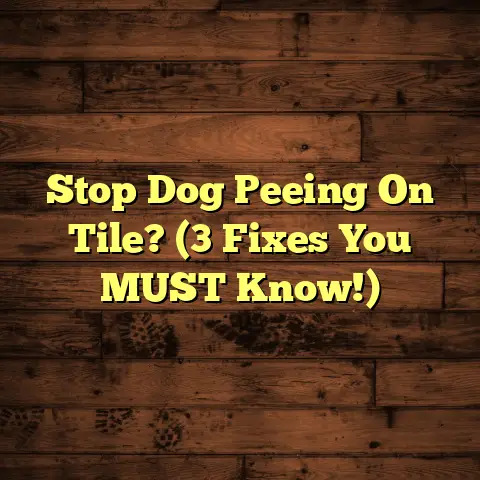DIY Concrete Stain Cost? (6 Costly Mistakes!)
Ever dreamt of turning that dull, gray concrete slab into a vibrant, eye-catching surface?
I’ve seen it countless times: homeowners, just like you, get inspired by those stunning stained patios and basements online.
The allure of saving money while achieving a professional-looking finish is strong!
But let me tell you, that DIY dream can quickly turn into a costly nightmare if you’re not careful.
I’m talking about mistakes that can double, or even triple, your initial budget.
Trust me, I’ve seen it all in my years as a flooring contractor.
So, before you grab that stain and start rolling, let’s dive into the real costs and those sneaky pitfalls you need to avoid.
Section 1: Understanding Concrete Staining Costs
1. Initial Costs Breakdown
Okay, so you’re ready to stain your concrete. Let’s break down what you’ll likely be paying for.
-
Stain: This is the heart of the project. You’ve got two main types:
-
Acid-based: These penetrate the concrete and create a permanent, mottled look.
They are usually cost \$30-\$50 per gallon. * Water-based: These are more like paints and offer a wider range of colors.
They are usually cost \$20-\$40 per gallon.
The type you choose will affect the final cost.
-
-
Sealer: This protects the stain and gives it that finished, professional look.
Expect to pay \$25-\$60 per gallon, depending on the quality and type (acrylic, polyurethane, etc.).
-
Tools: Don’t forget the essentials!
- Rollers: \$10-\$20 each.
- Brushes: \$5-\$15 each.
- Sprayer (optional, but recommended for large areas): \$50-\$200.
- Mixing buckets, gloves, safety glasses, etc.: \$20-\$50.
-
Safety Equipment: This is non-negotiable.
- Respirator: \$20-\$40.
- Gloves (acid-resistant if using acid-based stain): \$10-\$20.
- Eye protection: \$5-\$15.
Your health is worth more than cutting corners here.
So, as a rough estimate, for a small 200 sq ft patio, you might be looking at:
| Item | Estimated Cost |
|---|---|
| Stain (2 gallons) | \$40 – \$100 |
| Sealer (1 gallon) | \$25 – \$60 |
| Tools & Supplies | \$85 – \$235 |
| Safety Gear | \$35 – \$75 |
| Total | \$185 – \$470 |
Keep in mind that these are ballpark figures. The final cost can vary wildly.
2. Factors Influencing Cost
What really drives the price up? Several things:
-
Size of the area: Obvious, right? More square footage means more stain, more sealer, and more time.
-
Condition of the concrete: Is it cracked, stained with oil, or uneven?
You’ll need to factor in the cost of repairs, like concrete patching compound (\$15-\$30 per tub) or even professional grinding (\$3-\$8 per sq ft).
-
Type of stain: Acid-based stains often require neutralizing agents (\$10-\$20), adding to the cost.
-
Number of coats: Want a deeper, richer color? Multiple coats of stain will increase your material costs.
-
Sealer quality: Cheaper sealers might require more frequent reapplication, costing you more in the long run.
-
Regional price variations: Prices for materials can vary depending on where you live.
Call around to local suppliers to get the best deals.
Section 2: The 6 Costly Mistakes to Avoid
Alright, let’s get to the juicy part – the mistakes that can turn your DIY dream into a financial headache.
1. Mistake #1: Skipping Surface Preparation
This is where most DIYers go wrong. I can’t stress this enough: Proper surface preparation is absolutely crucial.
Think of it like painting a car. Would you just slap paint on a dirty, rusty surface? Of course not!
The same applies to concrete.
Any dirt, grease, oil, or existing coatings will prevent the stain from properly penetrating the concrete, leading to:
- Uneven color: Blotchy, inconsistent results.
- Poor adhesion: The stain might peel or flake off.
- Wasted stain: You’ll end up using more stain trying to compensate for the imperfections.
So, what does proper prep involve?
-
Cleaning: Thoroughly scrub the concrete with a degreasing cleaner and a stiff brush.
You might even need to use a pressure washer. I recommend Simple Green Concrete Cleaner, it usually costs \$15-\$20 per gallon.
-
Etching: This opens up the pores of the concrete, allowing the stain to penetrate better.
You can use muriatic acid (be extremely careful!) or a commercial concrete etcher (\$20-\$40 per gallon).
-
Rinsing: Rinse the concrete thoroughly with clean water to remove any residue from the cleaner or etcher.
-
Drying: Let the concrete dry completely before applying the stain.
This can take 24-48 hours, depending on the weather.
The Cost of Skipping Prep:
Imagine you skip the etching step. The stain doesn’t penetrate properly, resulting in a patchy, uneven mess.
Now you have to:
- Buy more stain to try and even it out.
- Rent a concrete grinder (\$70-\$100 per day) to remove the poorly adhered stain.
- Start the entire process over again, including proper cleaning and etching.
Suddenly, your “money-saving” DIY project has cost you an extra \$200-\$400 (or more!).
2. Mistake #2: Choosing the Wrong Stain Type
Acid-based vs. water-based: they’re not interchangeable. Choosing the wrong one can lead to disappointment and extra costs.
Acid-Based Stains:
-
Pros:
- Penetrate deeply for a permanent, durable finish.
- Create a unique, mottled look.
- Resistant to fading and chipping.
-
Cons:
- Limited color palette (earth tones are common).
- Require careful handling due to their corrosive nature.
- Can react unpredictably with existing concrete.
- Require neutralization after application.
Water-Based Stains:
-
Pros:
- Wide range of colors and shades.
- Easier to apply and clean up.
- More environmentally friendly.
-
Cons:
- Don’t penetrate as deeply as acid-based stains.
- May require more coats for desired color intensity.
- Can be more prone to fading and scratching.
- Require a high-quality sealer for protection.
The Cost of a Poor Stain Choice:
Let’s say you want a vibrant blue patio. You choose an acid-based stain, thinking it will be more durable.
But acid-based stains don’t come in bright blue! You end up with a muddy, brownish-blue mess.
Now you have to:
- Remove the acid stain (difficult and potentially dangerous).
- Rent a concrete grinder.
- Buy a water-based stain in the color you actually wanted.
- Apply multiple coats to achieve the desired vibrancy.
- Invest in a high-quality sealer to protect the water-based stain.
That color mismatch just cost you hundreds of dollars and a whole lot of frustration.
How to Avoid This:
- Research: Understand the properties of each stain type.
- Consider your desired look: What color and finish are you after?
- Read reviews: See what other DIYers have to say about specific brands and products.
- Consult with a professional: If you’re unsure, ask a flooring contractor for advice.
3. Mistake #3: Ignoring Weather Conditions
Concrete staining isn’t a project you can tackle anytime, anywhere.
Weather plays a huge role in how the stain adheres, cures, and ultimately looks.
-
Temperature: Extreme temperatures (too hot or too cold) can affect the stain’s drying time and adhesion.
- Too hot: The stain might dry too quickly, leading to uneven color and cracking.
- Too cold: The stain might not dry properly, resulting in a soft, tacky finish.
Most manufacturers recommend applying stains when temperatures are between 50°F and 90°F.
-
Humidity: High humidity can slow down the drying process and increase the risk of the stain blistering or peeling.
Avoid staining on rainy or very humid days.
-
Direct Sunlight: Direct sunlight can cause the stain to dry unevenly and fade prematurely.
Try to stain in the early morning or late afternoon when the sun is less intense.
The Cost of Ignoring the Weather:
Imagine you decide to stain your patio on a scorching summer day.
The stain dries almost instantly, leaving behind dark, uneven patches.
You try to apply a second coat to even it out, but it only makes things worse.
Now you have to:
- Rent a concrete grinder to remove the uneven stain.
- Wait for a day with more favorable weather conditions.
- Start the staining process over again.
That sunny day just cost you another \$100-\$200 in rental fees and wasted materials.
My Experience With Weather Conditions:
I worked on one project where the homeowner insisted on staining their driveway in late fall, despite my warnings.
The temperature was hovering around 40°F, and the humidity was high.
The stain took forever to dry, and even after several days, it was still tacky to the touch.
When winter arrived, the stain started to peel and flake off, leaving the driveway looking worse than before.
They ended up having to hire me to completely redo the project in the spring, at a significantly higher cost.
4. Mistake #4: Neglecting to Test Stain on a Small Area
This is a simple step that can save you a lot of heartache. Always, always, always test the stain on a small, inconspicuous area before applying it to the entire surface.
Why? Because:
- Concrete varies: Different concrete mixes and ages will react differently to the stain.
- Color can change: The color of the stain might look different on your concrete than it does on the sample card.
- Application technique matters: The way you apply the stain (roller, brush, sprayer) can affect the final result.
The Cost of Skipping the Test Patch:
Let’s say you’re staining your basement floor. You skip the test patch and apply the stain directly to the entire floor.
The color is completely wrong! It’s too dark, too light, or just plain ugly.
Now you have to:
- Figure out how to fix the color (which might involve applying multiple coats of different stains).
- Potentially rent a concrete grinder to remove the original stain if you can’t fix it.
- Live with a basement floor you hate.
That lack of a simple test patch just cost you a lot of money, time, and frustration.
How to Do a Proper Test Patch:
- Choose a small, inconspicuous area (like a corner or under a piece of furniture).
- Clean and etch the area as you would for the entire project.
- Apply the stain according to the manufacturer’s instructions.
- Let the stain dry completely.
- Apply the sealer.
- Evaluate the color and finish.
If you don’t like the results, you can try a different stain, a different application technique, or even consult with a professional.
5. Mistake #5: Failing to Apply a Proper Sealant
Sealing stained concrete is like applying a topcoat to your nails.
It protects the stain from wear and tear, enhances its color, and makes it easier to clean.
Skipping this step is a recipe for disaster.
Without a sealer, your stained concrete will be vulnerable to:
- Fading: The color will fade over time, especially in areas exposed to sunlight.
- Scratching: The surface will be easily scratched by furniture, foot traffic, and pets.
- Staining: Spills and dirt will penetrate the unprotected surface, leaving permanent stains.
- Chipping and peeling: The stain will start to chip and peel off, especially in high-traffic areas.
The Cost of Neglecting Sealing:
Imagine you stain your patio and skip the sealer. Within a few months, the color starts to fade, and the surface is covered in scratches and stains.
Every time it rains, the concrete absorbs water, leading to mold and mildew growth.
Now you have to:
- Thoroughly clean the patio to remove the mold and mildew.
- Apply a concrete cleaner and degreaser.
- Apply several coats of a concrete sealer.
You could have avoided all of that by simply applying a sealer in the first place!
Choosing the Right Sealer:
There are several types of concrete sealers available, each with its own pros and cons:
-
Acrylic Sealers: Affordable and easy to apply, but less durable than other options.
They are usually cost \$20-\$40 per gallon.
-
Polyurethane Sealers: More durable and resistant to chemicals, but more expensive and harder to apply.
They are usually cost \$40-\$60 per gallon.
-
Epoxy Sealers: The most durable option, but also the most expensive and difficult to apply.
They are usually cost \$50-\$80 per gallon.
Choose the sealer that best suits your needs and budget.
Important Sealing Tips:
- Apply the sealer according to the manufacturer’s instructions.
- Apply multiple thin coats rather than one thick coat.
- Allow the sealer to dry completely between coats.
- Reapply the sealer every 1-3 years, depending on the traffic and weather conditions.
6. Mistake #6: Underestimating the Time Commitment
DIY projects always seem to take longer than you expect, and concrete staining is no exception.
Don’t underestimate the time commitment involved.
Rushing the process can lead to mistakes, poor results, and ultimately, increased costs.
Here’s a realistic timeline for a small concrete staining project:
-
Day 1:
- Cleaning and etching: 4-6 hours
- Rinsing and drying: Allow 24-48 hours for complete drying.
-
Day 2 or 3:
- Staining: 2-4 hours per coat (allow drying time between coats).
- Neutralizing (if using acid-based stain): 1-2 hours.
-
Day 3 or 4:
- Sealing: 2-4 hours per coat (allow drying time between coats).
That’s a minimum of 2-4 days, depending on the size of the project, the type of stain, and the weather conditions.
The Cost of Rushing the Job:
Imagine you’re in a hurry to finish your patio before a big party.
You rush through the cleaning and etching process, apply the stain unevenly, and skip a coat of sealer.
The patio looks terrible, and you’re embarrassed to have guests over.
Now you have to:
- Apologize to your guests for the unsightly patio.
- Spend the next few weeks fixing the mistakes.
- Potentially hire a professional to redo the entire project.
That party just cost you a lot more than you bargained for.
How to Avoid Time-Related Mistakes:
- Plan ahead: Create a detailed schedule and stick to it.
- Allocate enough time: Don’t try to cram the entire project into one weekend.
- Be patient: Allow the stain and sealer to dry completely between coats.
- Don’t be afraid to ask for help: If you’re feeling overwhelmed, enlist the help of a friend or family member.
Section 3: Conclusion and Encouragement for Homeowners
DIY concrete staining can be an incredibly rewarding project.
It’s a chance to transform your space, add value to your home, and save money in the process.
But it’s also a project that requires careful planning, attention to detail, and a willingness to learn from your mistakes.
By understanding the costs involved, avoiding common pitfalls, and taking your time, you can achieve a beautiful, professional-looking finish that you’ll be proud of for years to come.
Don’t be afraid to tackle this project, but arm yourself with knowledge first.
Remember, a little preparation can save you a lot of money and frustration in the long run.
Good luck, and happy staining!





